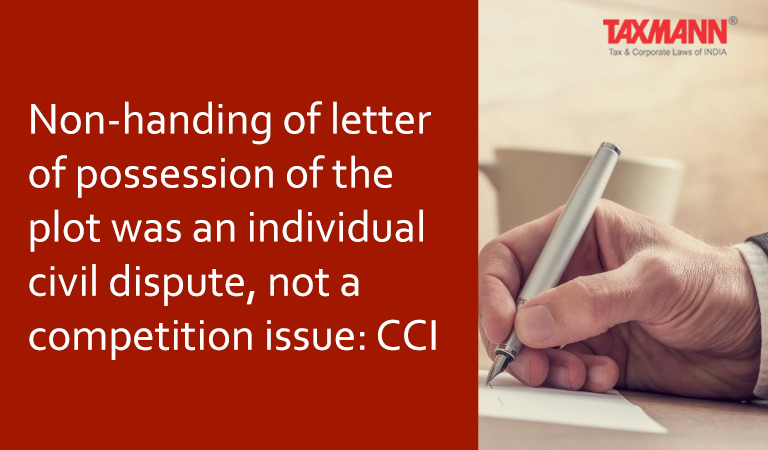Non-handing of letter of possession of the plot was an individual civil dispute, not a competition issue: CCI
- Blog|News|Competition Law|
- 2 Min Read
- By Taxmann
- |
- Last Updated on 1 December, 2021
Case Details: Mohd. Gaynor Haider v. Ghaziabad Development Authority - [2021] 132 taxmann.com 214 (CCI)
Judiciary and Counsel Details
-
- Ashok Kumar Gupta, Chairperson
- Sangeeta Verma and Bhagwant Singh Bishnoi, Member
Facts of the Case
In the instant case, information filed the informant under the Competition Act, 2002 against the Ghaziabad Development Authority and the State of Uttar Pradesh (collectively referred to as ‘Opposite Parties’) alleging contravention of the provisions of the Act.
Informant booked an apartment in one of OP’s residential schemes, which is stated to be an NRI at the time. According to the Informant, upon cancellation, OP offered him a refund of his money paid to date with an interest @5% p.a., or choice to apply under any new scheme floated by OP.
As per the Informant, he applied for an alternative allotment under OPs new scheme rather than taking his money back. He also gave all the original receipts of his payment made under the canceled scheme to OP. Against his new application, he is stated to have been allotted a plot. However, the Informant states that he never received a copy of the said allotment letter.
As per the Informant, the conduct of the Opposite Parties forced the Informant to take shelter of the process of law and bear the costs of all such proceedings without any fault on his part. Based on the above allegations and averments, the Informant has filed the instant Information praying the Commission to pass an order in his favor for possession of Plot.
CCI Held
The Commission noted that the Informant has not placed on record proper documentation in support of his factual averments. As such, the very fact of allotment of plot in his name for which possession is being claimed cannot be ascertained. Moreover, OP has stated to the Informant that the fact of his allotment is suspicious.
The Commission viewed that the facts and allegations made in the present Information were highly disputed and are essentially like an individual civil dispute between the Informant and OP rather than revealing any competition issue.
The Commission observed that there was nothing on record wherefrom even a prima facie case of contravention of any of the provisions of the Act can be made out against OPs in the present matter. As such, the Information was ordered to be closed forthwith in terms of the provisions contained in Section 26(2) of the Act.
Disclaimer: The content/information published on the website is only for general information of the user and shall not be construed as legal advice. While the Taxmann has exercised reasonable efforts to ensure the veracity of information/content published, Taxmann shall be under no liability in any manner whatsoever for incorrect information, if any.

Taxmann Publications has a dedicated in-house Research & Editorial Team. This team consists of a team of Chartered Accountants, Company Secretaries, and Lawyers. This team works under the guidance and supervision of editor-in-chief Mr Rakesh Bhargava.
The Research and Editorial Team is responsible for developing reliable and accurate content for the readers. The team follows the six-sigma approach to achieve the benchmark of zero error in its publications and research platforms. The team ensures that the following publication guidelines are thoroughly followed while developing the content:
- The statutory material is obtained only from the authorized and reliable sources
- All the latest developments in the judicial and legislative fields are covered
- Prepare the analytical write-ups on current, controversial, and important issues to help the readers to understand the concept and its implications
- Every content published by Taxmann is complete, accurate and lucid
- All evidence-based statements are supported with proper reference to Section, Circular No., Notification No. or citations
- The golden rules of grammar, style and consistency are thoroughly followed
- Font and size that’s easy to read and remain consistent across all imprint and digital publications are applied






 CA | CS | CMA
CA | CS | CMA


